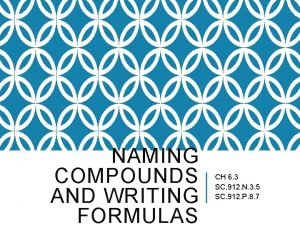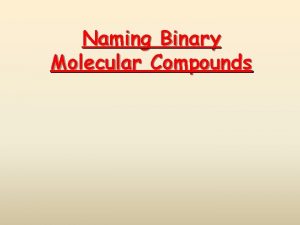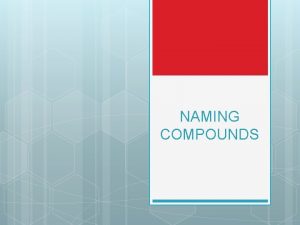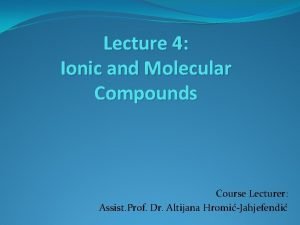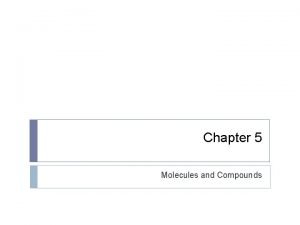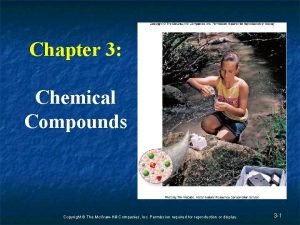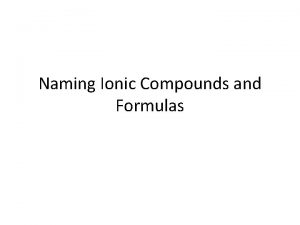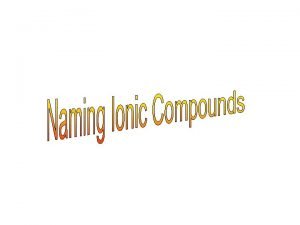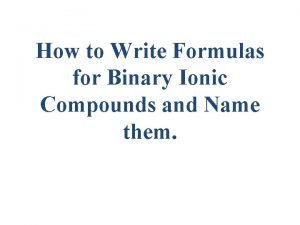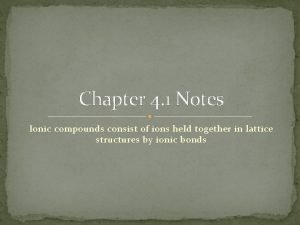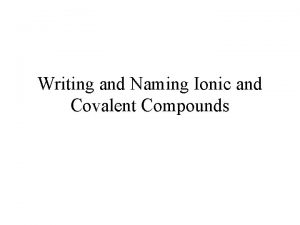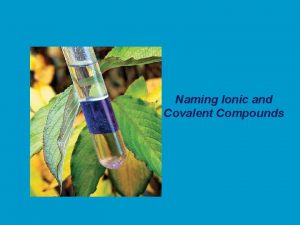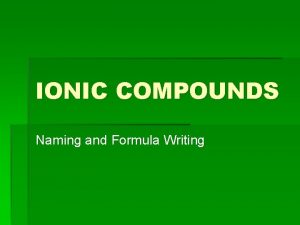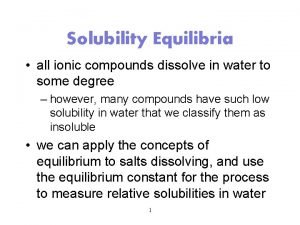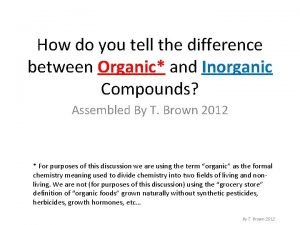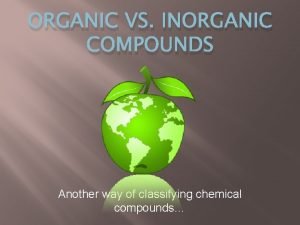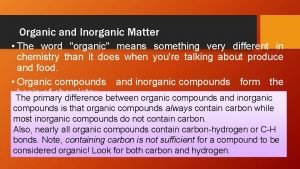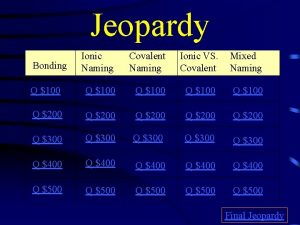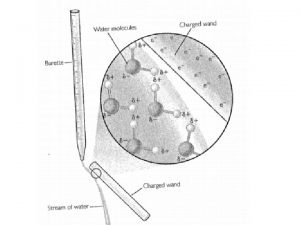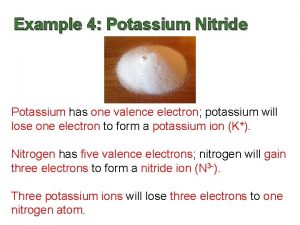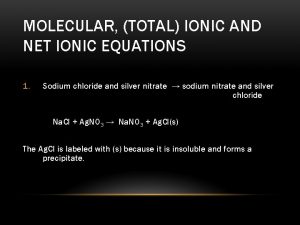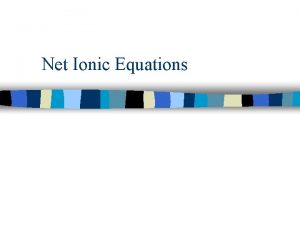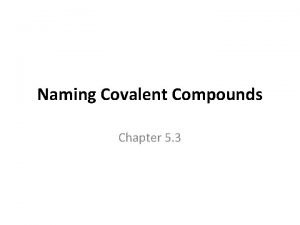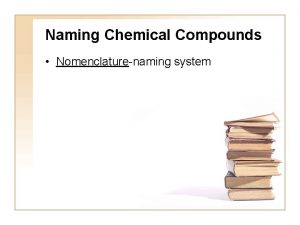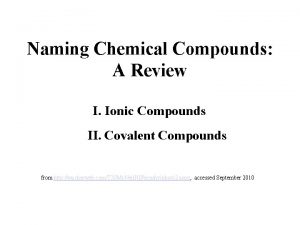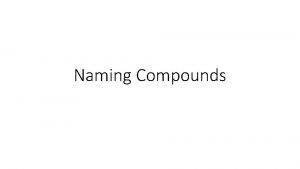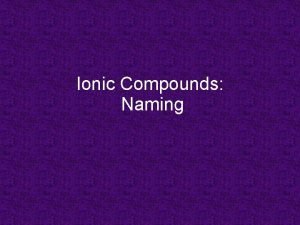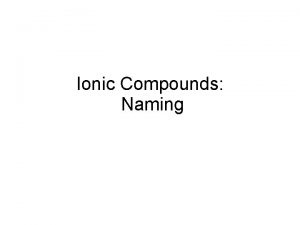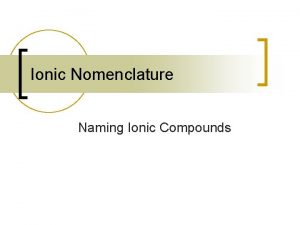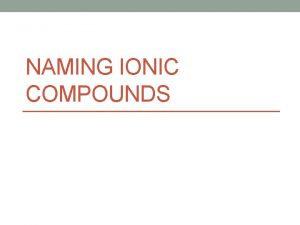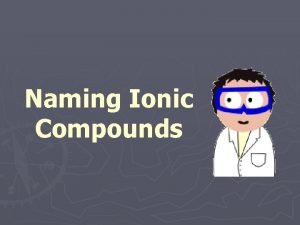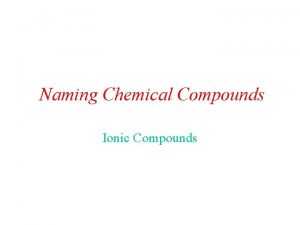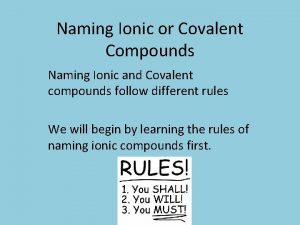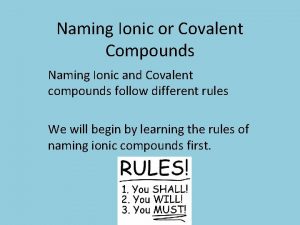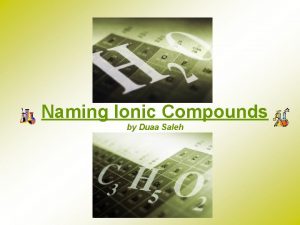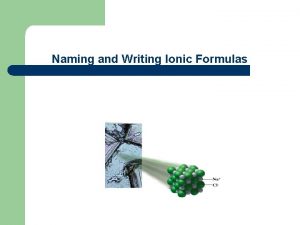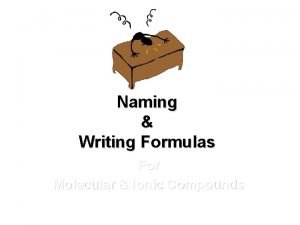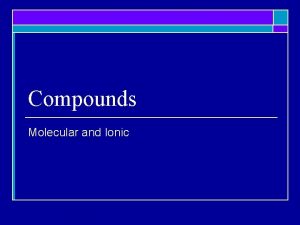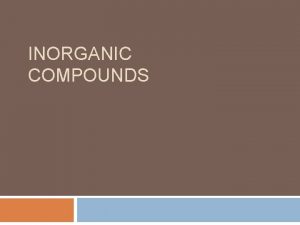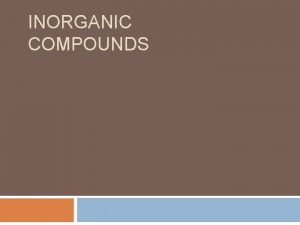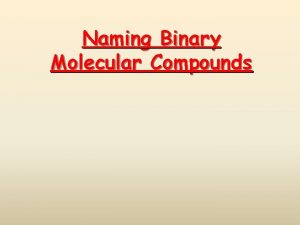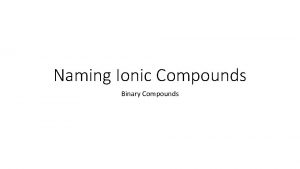MOLECULAR COMPOUNDS IONIC COMPOUNDS Naming Inorganic Compounds All










































- Slides: 42

MOLECULAR COMPOUNDS / IONIC COMPOUNDS

Naming Inorganic Compounds • All compounds can be written as a full name or as a chemical formula. A formula provides a short hand method of writing the compound. • sodium chloride Na. Cl(s)

Naming Binary Molecular Compounds 1) The full name of the first element in the compound is used. 2) The ending of the name of the second element in the compound is changed to “ide” (both names written in lower case) 3) A system of prefixes is used to indicate the number of each type of atom in the compound.

Naming Binary Molecular Compounds • • • 1 2 3 4 5 monoditritetrapenta- 6 7 8 9 10 hexaheptaoctanonadeca- GREEK PREFIX SYSTEM [ NONMETAL WITH NONMETAL ]

Naming Binary Molecular Compounds 4) The symbol for the elements are written in the same order as they appear in the name, followed by a subscript number to indicate the number of each atom in the compound

Examples • • • carbon dioxide CO 2 carbon monoxide CO iodine tribromide IBr 3 silicon tetrahydride Si. H 4 diphosphorus pentasulfide P 2 S 5

Naming Binary Ionic Compounds • The chemical formula of an ionic compound represents the lowest whole number ratio of the ions in the crystal and it is called a formula unit.

Naming Binary Ionic Compounds 1) Use the full name of the positive ion first. 2) Put the name of the negative ion last and change the ending to “ide” 3) The name of an ionic compound does not use prefixes to show the number of ions present

Naming Binary Ionic Compounds 4) When writing formulas of binary ionic compounds the symbol for the elements are written in the same order as they appear in the name. Subscript numbers are used to indicate the ratio of the ions in the compound.

Naming Binary Ionic Compounds 5)The charges on the ions must balance in the chemical formula, since ionic compounds are electrically neutral.

Examples of ionic compounds • • • sodium chloride magnesium chloride sodium phosphide silver sulfide zinc nitride Na. Cl Mg. Cl 2 Na 3 P Ag 2 S Zn 3 N 2

Criss-cross method • 3+ Al and Cl • Al. Cl 3 • Cu 2+ and O 2 • Cu. O

Naming ionic compounds formed by transition elements • Some of the transition elements can form more than one common type of ion.

Atomic # symbol 26 3+ Fe iron (III) 2+ Fe iron (II) ion charge Stock name

Stock System • The stock system uses Roman numerals after the name of the positive (metal) ion to indicate the charge on that ion. • Example: iron (II) oxide • iron (III) oxide

Stock system examples • Copper can be either Cu 2+ or Cu+. In combination with oxygen each ion will form a different compound. • copper (II) oxide Cu. O • copper (I) oxide Cu 2 O

The Classical System • The classical system uses different suffixes(endings) to indicate the possible charges on the ion.

The Classical System • The ending “ic” indicates the higher of the two possible charges. • The ending “ous” indicates the lower of the two possible charges. • chromic refers to Cr 3+ • chromous refers to Cr 2+ • These endings are added to the name of the transition element

Examples • Write the formulas of chromic nitride and chromous sulfide. • Cr. N & Cr. S • Write the names for Fe 3 P 2 and Mn 3 P 4 • iron (II) phosphide • manganese (IV) phosphide

Polyatomic ions • Polyatomic ions consist of a group of atoms combined together which have an overall charge.

Naming polyatomic ions • Polyatomic ions, being negative, are always written last in the name of the formula, except for ammonium (+), it is written first.

Naming polyatomic ions • When writing the formula for compounds containing more than one of a polyatomic ion, the symbol for the ion must be written in brackets. • A subscript number is added to indicate the number of polyatomic ions present in the compound.

Examples of polyatomic ions • Ammonium sulfate NH 4+ SO 42 • (NH 4)2 SO 4 • Tin (II) nitrate • Sn(NO 3)2 Sn 2+ NO 3 -

Hydrated compounds • ionic compounds that have water molecules associated with their crystal structure. • anhydrous compound: – hydrates that lose water; usually a different colour.

Hydrated molecular formula copper sulfate pentahydrate copper sulfate

Naming Hydrates • When writing the formula for hydrated crystal of an ionic compound a dot is placed between the formula and the number of water molecules. • Greek prefixes used to indicate how many water molecules are present. • copper(II) sulfate pentahydrate • Cu. SO 4● 5 H 2 O

Acids and Bases

Acids • Acids are compounds that contain hydrogen atoms covalently bonded to other atoms to form a molecular compound.

Bases • Bases are ionic compounds that are able to release hydroxide ions (OH-) in solution. • Bases react with acids to produce a neutral solution of salt and water. • HCl(aq) + Na. OH(aq)―>H 2 O(l) + Na. Cl(aq)

Naming Acids • All acids will be considered as being dissolved in water, ie. In aqueous solution and this must always be indicated by placing the subscript (aq) after the acid formula. • Acids can be named in two ways. Both systems are equally acceptable to the IUPAC.

IUPAC system • The IUPAC system places the word aqueous in front of the name of the acid, named as if it were an ionic compound. • Example: HCl (g) is named as hydrogen chloride, but dissolved in water it becomes an acid called aqueous hydrogen chloride, and its formula is HCl (aq).

The classical system • The names of hydrogen compounds when named as ionic compounds will end in ide, ate or ite. • There are three naming rules based on each of these three possible endings.

Rule 1 • When the name of the negative ion ends in -ide the acid begins with the prefix hydroand the stem of the negative ion is given the ending –ic, in place of –ide. This is followed by the word acid. • HCl(aq) would be named as hydrogen chloride and so becomes hydrochloric acid.

Examples • • • HF(aq) hydroflouric acid HBr(aq) hydrobromic acid HI(aq) hydroiodic acid

Rule 2 • When the negative ion ends in –ate the acid name is the stem of the negative ion given the ending –ic , in place of –ate , followed by the word acid. • HCl. O 3(aq) would be named hydrogen chlorate and so becomes chloric acid.

Examples • • H 2 CO 3(aq) carbonic acid HNO 3(aq) nitric acid

Rule 3 • When the negative ion ends in –ite the acid name is the stem of the negative ion given the ending –ous , in the place of – ite, followed by the word acid. • Example: HNO 2(aq) would be named hydrogen nitrite and so becomes nitrous acid.

Examples • • H 2 SO 3(aq) sulphurous acid HCl. O 2(aq) chlorous acid

Writing names of acids • Writing names of the acids is simply the reverse of the rules above.

Exceptions to the rules • Acids which have sulf- or phosph- as their roots have extra letters added to make the name sound better. • Sulf- has -ur added so that it becomes sulfuric or sulfurous. • Phosph- has –or added to it to become phosphoric and phosphorous.

Exceptions to the rules • When the formula for the acid contains COO, the hydrogen atom is placed at the end of the formula after the COO. • • ethanoic acid is written as CH 3 COOH Oxalic acid is written H 2 OOCCOO or HOOCCOOH / HO 2 C 2 O 2 H condensed Benzoic acid HC 6 H 5 COO / C 6 H 5 COOH

• Always remember, when writing the formula of an acid, to indicate that it is an acid by placing the subscript (aq) after the formula.
 Naming and writing formulas for molecular compounds
Naming and writing formulas for molecular compounds What are binary molecular compounds
What are binary molecular compounds Name of so4
Name of so4 Naming molecular compounds
Naming molecular compounds Naming molecular compounds
Naming molecular compounds Naming molecular compounds
Naming molecular compounds Steps to naming ionic compounds
Steps to naming ionic compounds Naming ionic compounds
Naming ionic compounds Ag3po4compound name
Ag3po4compound name Rules for naming ionic compounds
Rules for naming ionic compounds Naming binary compounds ionic
Naming binary compounds ionic Writing binary formulas
Writing binary formulas Concept 2 notes naming ionic compounds
Concept 2 notes naming ionic compounds Writing chemical formulas criss cross method
Writing chemical formulas criss cross method Monatomic formula
Monatomic formula Naming ionic compounds flowchart
Naming ionic compounds flowchart Review naming ionic compounds
Review naming ionic compounds Naming ionic vs covalent compounds
Naming ionic vs covalent compounds Covalent compound hi
Covalent compound hi Naming binary compounds ionic
Naming binary compounds ionic Naming binary ionic compounds
Naming binary ionic compounds Predicting and naming ionic compounds
Predicting and naming ionic compounds Venn diagram of ionic, covalent and metallic bonds
Venn diagram of ionic, covalent and metallic bonds Are all ionic compounds soluble in water
Are all ionic compounds soluble in water Charring test of organic and inorganic compounds
Charring test of organic and inorganic compounds Organic vs inorganic compounds
Organic vs inorganic compounds What is the difference between organic and inorganic
What is the difference between organic and inorganic Organic vs inorganic compounds
Organic vs inorganic compounds Indian pharmacopoeia inorganic chemistry
Indian pharmacopoeia inorganic chemistry Organic versus inorganic compounds
Organic versus inorganic compounds Mixed ionic and covalent naming
Mixed ionic and covalent naming Covalently bonded substances
Covalently bonded substances Ionic covalent metallic
Ionic covalent metallic Zinc oxide + nitric acid → zinc nitrate + water
Zinc oxide + nitric acid → zinc nitrate + water Molecular bond vs ionic bond
Molecular bond vs ionic bond Number of valence electrons in potassium
Number of valence electrons in potassium Sodium nitrate and silver nitrate
Sodium nitrate and silver nitrate Net equation
Net equation Metallic bond naming
Metallic bond naming Priority of functional groups in iupac nomenclature
Priority of functional groups in iupac nomenclature Covalent compound formula phosphorus pentafluoride
Covalent compound formula phosphorus pentafluoride Carbon monoxide formual
Carbon monoxide formual When to use prefixes for naming compounds
When to use prefixes for naming compounds
